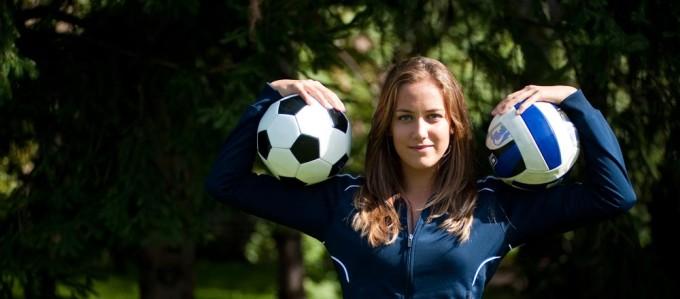Between class and practice, the life of a student-athlete is hectic enough. Shannon Baldwin examines what it’s like playing for two varsity teams
It’s a balancing act most university students would never attempt. Now in her third year at Ryerson, Katrina Gonyea decided to switch programs from physics to arts and contemporary studies and while she already had a major commitment playing for the women’s volleyball team the previous two seasons, she joined the soccer team as well.
“I had no idea I could do both,” says Gonyea. “When I got out of high school, I always thought I had to choose one.” A three-sport star (she was also the most valuable player in basketball) at Cardinal Carter High School in Aurora, Gonyea chose to focus on volleyball at Ryerson until her coach, Dustin Reid, told her she had the option to play for two teams.
One factor allowing Gonyea to play both soccer and volleyball is that their schedules have minimal overlap – soccer’s regular season runs from early September to late October, while volleyball runs from early October to mid-February – meaning she doesn’t have to split her time 50/50 between the two sports.
“Right now, I’m devoting 100 per cent of my time to soccer,” said Gonyea.
“But every once in a while I like to show my face at some of the volleyball practices so they know I’m still a part of the team.” Fellow soccer player Amy Tahmizian, a third-year fashion design student, says she would consider taking up another varsity sport if Ryerson offered a legitimate track program, but still advises others to only do one sport at a time. Women’s soccer coach Kevin Souter agrees.
“It’s a very hard thing to do, from a coaches point of view,” says Souter.
“I like to have my girls dedicated to one sport.” Yet he’s not opposed to Gonyea pulling double duty because she already knows what to expect from a varsity team. He says the biggest challenge with first-year players is bringing them out of the high school mentality of what they perceive to be commitment and how to balance academics and athletics. So when athletic teams recruit, they make new athletes choose one sport.
With so much of her time taken up by practices and commuting downtown, Gonyea still has to make time to focus on her grades – which she prioritizes “because without them
[she] couldn’t play sports.” Ryerson offers athletes a strong support system to help maintain their grades – from workshops to improve note-taking to mandatory study sessions for first-year athletes.
But while coaches encourage strong academics, Gonyea says that the majority of Ryerson professors don’t support athletes.
“During the first week of school, a letter goes out [to warn professors] about any potential conflicts,” she says. “[But] they don’t care if you’re on a sports team. I think that’s just the mentality of Canadian schools, they don’t care enough about sports.” Souter says the possibility of a burnout is a concern for any dual-sort athlete, because “varsity sports are demanding and Ryerson’s a demanding school,” but Gonyea says having to balance soccer, volleyball and school doesn’t affect her negatively.
“I always need to be doing something,” she says. “[And] I never feel like I’m missing out on a social life because my friends are my teammates.” As long as they are motivated and are prepared to put in the work, Gonyea says any student can play two varsity sports.
“I’m not a superstar player or anything like that. I just practice hard with the team that I’m on and support the other from the bench.”










Leave a Reply